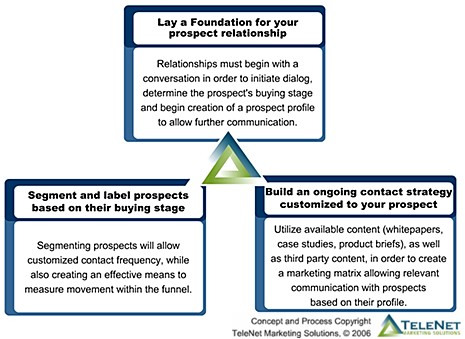"Lead nurturing" is commonly referred to in marketing publications and blogs, and frequently discussed at B2B marketing events. Defined as "a relationship-building approach utilizing multiple media to provide relevant information tailored to prospects while engaging in an ongoing dialog until qualified prospects are 'sales ready,'" lead nurturing has become an integral component of an overall marketing strategy.
Though there is an ever-growing incentive to implement an effective lead-nurturing strategy with business partners and prospects, determining which specific tactics to use can prove challenging.
Listening to industry experts can be confusing and, in many cases, inadequate. Recently, I had the opportunity to listen to one of the industry's best-known speakers explain the lead-nurturing tactics that he has implemented for one of his clients. He defined lead nurturing and its benefits perfectly. However, as he described his specific tactics, it became evident that he was inappropriately grouping all prospects into one "nurturing funnel" and treating all prospects in the exact same manner.
For instance, he suggested calling all the prospects initially to tele-qualify them (a good first step!), but then he suggested putting all qualified prospects on the exact same schedule to receive the same emails monthly, calls quarterly, etc.
Part of the definition of "lead nurturing" is to "provide relevant information tailored to the prospect." Assuming that prospects have unique needs, priorities, and timeframes, scheduling batch communications is far from ideal.
For the past 15 years, I've worked in the marketing services industry. Part of my job entails consulting with companies about their marketing-lead strategies. Increasingly, it seems that companies are starving for information on how to implement successful lead-nurturing tactics.
One such company asked for my opinion on its internal group's lead-nurturing strategy. Its strategy involved using the phone (no additional media) to call each prospect every nine months to check in on the prospect's progress. Since lead nurturing should include multiple media and the contact strategy should be customized based on the prospect's situation, calling everyone in the same time intervals typically does not produce the best results.
Most marketing executives understand that lead nurturing is an effective way to cultivate prospect relationships and ultimately drive sales. Unfortunately, experts in the field have published very little in the way of practical suggestions for implementing and improving a lead nurturing strategy.
To help fill this knowledge gap, I have developed a list of six real-world tactics designed to help make sense of the otherwise daunting task of lead nurturing.
Useful tactic #1: Find out what is important to your prospects.
Call and ask pointed questions. Doing so will provide the information necessary to appropriately categorize each prospect. For instance, if you sell storage solutions, you should ask your prospects to explain their top storage environment challenges (answers may include security, reliability, scalability, etc).
Asking meaningful profiling questions will allow you to better understand prospects and categorize each, in order to move forward with a relevant nurturing strategy.
Useful tactic #2: Develop a marketing matrix based on key categories and align your existing content.
For instance, using the storage example noted above, build a matrix showing each major storage challenge and the content that you have that illustrates how your company can solve or assist in meeting the challenge. Look at your content, including product briefs, case studies, whitepapers, on-demand webinars, etc., and organize everything within the matrix.
Also, look at third-party content, which is a great way to add to your nurturing strategy at little or no expense.

Useful tactic #3: Contact your prospect at the opportune time.
When determining the frequency of contact, consider four important items:
- Always look for direction from your prospect (e.g., "please call me back in two weeks").
- When appropriate, recommend your next contact based on the buying stage of the prospect (e.g., "based on what you're telling me, I think it makes sense to contact you again in April").
- Consider the receptiveness of each of your prospects. If they are hungry for information, shorten the intervals between communications.
- Finally, look for triggering events. For instance, you can use a service such as Hoovers to receive alerts when your top prospects are in the news. Certain newsworthy events, such as a major acquisition, may serve as an opportune time for you to contact your prospect.
Useful tactic #4: Do not spend time and money creating graphic-rich HTML emails.
A nurturing strategy is based on a relationship-building approach. Therefore, the best way to integrate email is to develop plain-text email templates that can be quickly customized and sent from your nurturing agent to the appropriate prospects.
It is important that your emails be perceived as relevant one-to-one communications and not come across as mass-marketing or advertising pieces.
Useful tactic #5: Pay attention to your email bounce-backs.
A bounce-back may mean that one of your key prospects has left the company. Turnover can mean a change in priorities, new projects, and new challenges. You should react to a bounce-back with a telephone call to check the status of your nurtured account.
Useful tactic #6: Categorize your prospects.
Create three major groups so you can measure and monitor your prospects' movement within your nurturing funnel:
- Passive prospects are those who are qualified to buy your products/services but do not have a defined need.
- Active prospects are those who are qualified and have a potential or defined need.
- Sales-ready prospects are those who meet the definition of a lead for your sales team.
The goal of your nurturing strategy is to move prospects from passive to active to sales-ready.
* * *
These are just a handful of the most important tactics necessary for success. As you continue to refine your lead nurturing process, be sure monitor your progress by asking yourself two simple questions:
- Are we providing relevant information with each communication?
- Are we successfully moving prospects through the sales funnel?
If you answer "yes" to both of these questions, you are on your way to effectively incorporating lead nurturing into your overall marketing strategy.




